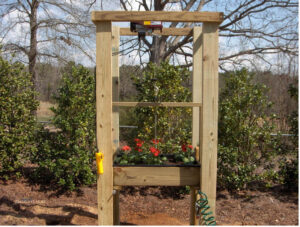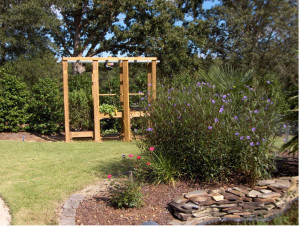INTRODUCTION TO VARIABLE LEVEL ADAPTIVE GARDENING, NO BENDING, NO STOOPING
PART 1
There are three major methods used in growing vegetables, (1) traditional or conventional row gardening, (2) raised bed gardening (3) container gardening. I was introduced to conventional row gardening in the 1940’s as a child helping my grandfather in his garden. Once the land had been “broken” with a horse named “Dolly”, we would plant, fertilize, weed and harvest our bounty. I sometimes think that this was done to feed the bugs and worms that came to visit. Grandmother would “slave over a hot kitchen stove” and can tomatoes, okra, peas, beans, sweet corn and squash, to mention a few. Each planting seemed to come off at one time in abundance.
The method of raised bed gardening is several hundred years old and thought to have originated in Eastern Europe and Germany known as hugelkulter. Pronounce (hoo-gel-culture) in German meaning mound culture or mound growing. Wooden logs and limb debris were covered with straw, animal manure, grass and soil dug from adjacent areas alongside each hugelkuklter. Some of these mounds would be about 6 feet wide, 4 feet high and as long as one wanted.
Although the American colonists grew small, compact plots of vegetables, the art of raised bed gardening was not known until Alan Chadwick a well-known English master gardener introduce the method “French Intensive Gardening” to America in 1960’s and 1970’s. Chadwick’s raised bed method consisted of layers of soil and compost 2 feet deep. Today, most raised beds are bordered with wooden timbers in beds 4 feet wide by 8 to 10 feet long and 6 inches to waist high. They are located in yards with limited space.
The method of container growing was used in ancient Egypt to transport plants, Babylonia 604 B.C. to create the hanging gardens and China 200 B.C. to grow bonsai trees. The American colonists grew plants in clay containers to decorate their estates. The first recorded plant being sold in a container was In 1801 was Grant Thorburn, owner of a famous seed house in New York City, when he sold a rose geranium while on display in his grocery store.
Clay and metal tin cans where surpassed by plastic containers following the end of World War II. The commercial nursery industry lead the way in growing and selling tree and shrub container plants. The idea of growing vegetables in containers begin to spark interest with the advent of less expensive plastic containers, particularly with homeowners. Most homeowners were more urbanized and lived on smaller yards than their parents. Today, most container growing is on a small scale located on patios.
In April 2012, I presented a talk to the Palmetto Richland Memorial Hospital in Columbia, S.C. on the subject of gardening for patients that had operations for hip and knee replacements. The object of the meeting was to get the patients outside, get fresh air and carefully move through the motions of gardening in general, traditional row gardening. Most of the 50 people present where in their 60’s and 70’s. They needed help. Why not an ultimate adaptive garden?
About 6 weeks before the presentation, I awoke in the middle of the night and the thought came to me, why not devise a container garden that would be waist high like a raised bed garden. That’s right, raised bed gardens can be constructed as high as the waist. Yes, there are container gardens resting on the tops of tables, but how could gardeners in wheelchairs harvest fruit on vertical frames above their reach? There must be a way. Then the lights came on. Lower the bottom of the vertical frame down to the ground level. An overhead electric wench connected to a container would do the trick. An idea was born.
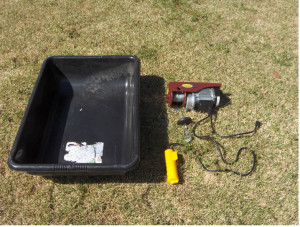 Picture of first container and electric hoist 5 March 2012. Treated lumber not shown
Picture of first container and electric hoist 5 March 2012. Treated lumber not shown
The following are pictures of the original Variable Level Adaptive garden, showing a gardener with a heart condition and that had a knee replacement. He thought it was the best thing since sliced bread.
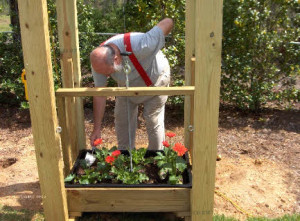
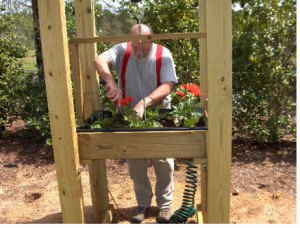
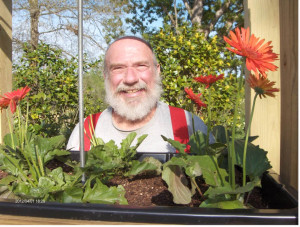
A Variable Level Adaptive Garden (VLAG) is a container garden I invented to assist gardeners of all ages, especially those that have lost to some degree the movement of their limbs, those that have painful joints and muscles and the elderly by controlling the vertical and horizontal movements of the garden.
The original VLAG was hastily constructed, and you guessed it, connecting the stationary electric hoist to the container.
Picture showing the first VLAG on 15 March 2012. Hoist cable barely visible.
The next hurdle to jump was to construct additional VLAG units using the same electric hoist. An overhead track system had to be installed. It was soon discovered that overhead garage door tracks were too weak. Something had to be stronger. What about attaching the overhead hoist to a set of barn door tracks for sliding doors?
This picture 12 Sept, 2012 shows 2 more VLAG units to the right sharing a common electric hoist.
This article concludes Part 1 of INTRODUCTION OF THE VARIABLE LEVEL ADAPTIVE GARDEN, NO BENDING, NO STOOPING. The inventor, Ron Cowart, is available for lectures to various organizations such as schools, retirement homes, hospitals, news media and garden clubs to mention a few. Contact Ron Cowart, cowartconsulting@gmail.com or (803) 438-2462 for more information.



